Etchū-Ebara Station
Etchū-Ebara Station (越中荏原駅, Etchū-Ebara-eki) is a train station in the city of Toyama, Toyama Prefecture, Japan.
Etchū-Ebara Station 越中荏原駅 | |
|---|---|
 Etchū-Ebara Station in 2010 | |
| Location | 2-13-7 Shinjo, Toyama-shi, Toyama-ken 930-0916 Japan |
| Coordinates | 36.6991°N 137.2664°E |
| Operated by | |
| Line(s) | ■ Toyama Chihō Railway Main Line |
| Distance | 4.7 km from Dentetsu-Toyama |
| Platforms | 1 island platform |
| Tracks | 2 |
| Other information | |
| Status | Staffed |
| Website | Official website |
| History | |
| Opened | 15 August 1931 |
| Rebuilt | 2010 |
| Previous names | Shimamura Station (to 1945) |
| Traffic | |
| Passengers (FY2015) | 929 |
| Location | |
 Etchū-Ebara Station Location within Japan | |
Lines
Etchū-Ebara Station is served by the Toyama Chihō Railway Main Line, and is 4.7 kilometers from the starting point of the line at Dentetsu-Toyama.
Station layout
The station has one ground-level island platform serving two tracks. The station is staffed.
Platforms
| 1 | ■ Toyama Chihō Railway Main Line | for Dentetsu Toyama |
| 2 | ■ Toyama Chihō Railway Main Line | for Kamiichi, Dentetsu-Uozu and Unazuki-Onsen |
History
Etchū-Ebara Station was opened on 7 November 1931 as Shimamura Station (島村駅, Shimamura-eki). It was renamed to its present name on 21 September 1945. A new station building was completed in March 2010.
Adjacent stations
| « | Service | » | ||
|---|---|---|---|---|
| Toyama Chihō Railway Main Line | ||||
| Limited Express: Does not stop at this station | ||||
| Rapid Express: Does not stop at this station | ||||
| Higashi-Shinjō | Express | Etchū-Sangō | ||
| Higashi-Shinjō | Local | Etchū-Sangō | ||
Surrounding area
- Dai-Ichi High School
gollark: Wasn't me.
gollark: Um, ale said I got banned for something?
gollark: and get the nice infinite range stuff.
gollark: <@151391317740486657> browsers bad
gollark: 🌵
See also
This article is issued from Wikipedia. The text is licensed under Creative Commons - Attribution - Sharealike. Additional terms may apply for the media files.